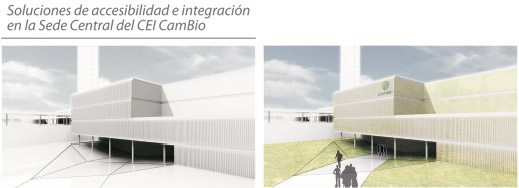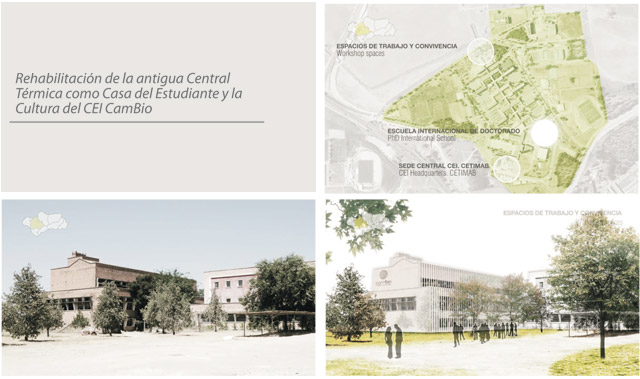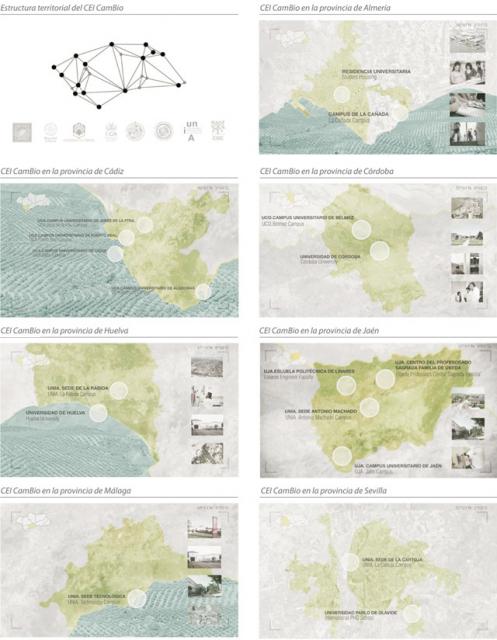Infraestructuras CEI CamBio 2011
ACTION AVENUES AND MANAGEMENT STRUCTURE FOR THE TRANSFORMATION OF THE CAMPUS
CEI CamBio’s commitment to transforming the campus towards the development of a comprehensive social model and interaction with the territorial environment will materialise in a series of actions regarding accommodation, accessibility, socio-environmental sustainability, IT solutions and the promotion of socio-economic development and territorial cohesion.
Additionally, regarding urbanism and architectural design, the CEI has taken steps to ensure a style which is homogenous, recognisable and integrated into the landscape. These actions are also attentive to internal design, especially with regard to multi-functionality.
The management structures from which the CEI will articulate these transformation policies will be Sustainability and Creativity and Innovation Areas within the Consortium CamBio.
L.1. Plan for improved accommodation facilities
The development of a network of university accommodation facilities is key for the promotion of mobility among university community members and the full realisation of research and teaching activities within the CEI.
All actions proposed in this regard insist on the modernisation and the social and economic dynamisation of coalition members. Additionally, the creation and rehabilitation of accommodation facilities will also favour the interaction of community members.
These general ideas will crystallise in the construction of the following halls of residence, complementing CamBio’s current offer, to ensure the development of a true accommodation network:
A.1. Residencia Universitaria, University of Almería Campus

A.2. Residencia Universitaria, Campus de la Bahía de Algeciras, University of Cádiz .

A.3. Residencia Universitaria, Campus Rabanales, University of Córdoba.

A.4. Residencia Universitaria, Campus del Carmen, University of Huelva.

L.2. Plan for universal accessibility
The Real Decreto 1393/2007, October 29, Ordenación de las Enseñanzas Universitarias Oficiales, defines ‘accessibility’ as an area of responsibility for the entire university community. Literally, the text states that ‘material equipment and services (spaces, facilities, laboratories, scientific, technical and artistic equipment, libraries, reading rooms, new technologies, etc.) are sufficient to guarantee the full development of educational activities following full accessibility criteria’. For this reason, the actions proposed here are not only related to the quality of life on the campus, as defined by the Spanish Committee for the Representation of the Disabled (CERMI), but also with a lateral skill to be acquired by the entire student body.
From this starting point and, as previously mentioned, following the recommendations issued by Vía Libre and Technosite, Grupo Fundosa (Fundación ONCE) CamBio proposes to implement to following action
A.1. Transport needs diagnosis and adoption of appropriate measures: the aim of this is to diagnose and adapt public transport (bus, metro, train, etc.) to all needs.
A.2. Campus signalling programme: Braille signs in classrooms, buildings, services, offices and other key spaces within the campus, and the creation of e-information points accessible by wheelchair.
A.3. Programme for the elimination of architectonic barriers: this programme will play special attention to the key spaces within the campus (events halls, sporting facilities, etc.). In this regard, ensuring accessibility to the spaces where the most relevant academic activities are carried out is a priority, along with the installation of magnetic induction loops in such spaces. Full accessibility to sport facilities is another priority, including the adaptation of changing rooms and the installation of elevators in swimming pools.

A.4. Creation of adapted information points in computer rooms and libraries: This will involve the installation of adaptable tables. Regarding computer hardware, Braille printers, electronic magnifiers, scanners, computers and laptops adapted to Daysi and MP3 formats, optical readers,
etc. will be made available. Regarding software, screen readers, magnifiers, reproduction programmes, programmes for the creation and edition of audio files from text files, Braille translators and e-dictionaries for the blind will also be on offer.
A.5. Programme for the deaf: this action will be carried out in coordination with the reorganisation of road traffic within the campus and with the installation of light signals inside buildings.
A.6. Programme towards the integration of students with special needs: programme aimed at the tailoring of teaching tools to suit students with special needs, whenever general resources do not cover these needs. The implantation of these resources will be gradual.
L.3. Socio-environmental sustainability plan
As has been noted above, CEI CamBio has tailored a good deal of the project’s programmes towards environmental sustainability to the targets set forth in the Ley de Economía Sostenible, most particularly in the development of energy efficiency plans and the measurement, reduction and palliation of the carbon footprint.
This complements other actions aimed at improving the quality of life of the CEI community, through the improvement of sporting facilities and the promotion of physical activity, the creation of spaces for social interaction and the promotion of artistic expression.
A.1. Environmental rehabilitation and tree repopulation plan: Human pressure and the intensive use of open spaces are inherent to the sort of activity carried out on university campuses, and they must be taken into account for the sustainable design of green areas. In order to ensure that this design complies with the highest environmental standards, the intrinsic natural value of open spaces also needs to be accounted for. As a general philosophy, university campuses must contemplate the existence of green urban areas -lawns and wooded areas, gardens in combination with buildings, etc.- for the recreation of the university community and other visitors. On the other hand, campuses must have building-free areas aimed at the preservation/restoration of pre-human action natural conditions and at the promotion of environmentally-friendly attitudes. In order to make these environmental restoration plans compatible with the activities typically carried out on university campuses, these natural spaces must coexist with urban parks and gardens where water plays a prominent role. For this, and with consideration of the micro-climatic conditions of each campus, programmes towards the increase of urban tree populations will be implemented, especially around buildings. The target is to achieve tree coverage rates of 40%, for which pruning and planting activities have already been launched. This target will be achieved by increasing tree population by 7% per year over a 5 year period.
A.2. Programme for the improvement of sporting facilities and the promotion of physical activity: In this regard, a number of actions will be implemented, with the aim of increasing and optimising available human and material resources for the promotion of physical activity, not only within CEI CamBio, but in general. The proposed actions are as follows:
- Installation of solar energy and salt electrolysis systems: the solar energy systems will ensure hot water supply in changing rooms and acclimatised swimming pools. Similarly, salt electrolysis will substitute chlorine-based purification systems in swimming pools, resulting in better quality water and air, through the in situ production of chlorine, and a more efficient use of water.
- Improved accessibility to sporting facilities: all CEI CamBio member universities will take steps to ensure full accessibility to sporting facilities, through the adaptation of infrastructures and the organisation of activities duly tailored to the needs of these community members.
- Adaptation of the most popular sporting facilities: the growing demand for sporting facilities for academic purposes (sport science degrees and post-graduate degrees) and the open access policy followed with the general public require the construction of particularly popular sporting facilities such as football and rugby pitches, which also have to be adapted to accessibility and control needs in order to ensure full performance and efficient management.
- Promotion of physical activity through cooperation with federations, clubs and elite athletes: CEI CamBio aims to design a programme for the promotion of physical activity, including the shared use of facilities, the organisation of conferences, the involvement of sport science degrees in sporting activities, sports exhibitions, etc. This will be carried out in cooperation with:
- Federations, with which several agreements already exist, including those for minority sports in order to cover the entire range of demand.
- Clubs, especially those with programmes for schoolchildren, such as the Club Gimnástico Sur, which cooperates with the University Pablo de Olavide.
- Elite athletes and high performance centres, in order to facilitate the simultaneous practice of sports and university studies through programmes for the optimised used of available resources.
A.3. Programme for the promotion of culture and artistic creativity: As we have mentioned above, the new Estatuto del Estudiante Universitario establishes a series of principles regarding social interaction and active social participation for university students which, in addition to the project’s aim to facilitate students with the chance to spend fruitful, full working days on campus, requires universities to offer the necessary facilities: In this sense, the proposed actions are as follows:
- Rehabilitation of the former Central Térmica (Thermal Power Station), Universidad Laboral (current University Pablo de Olavide) as Casa del Estudiante y la Cultura (Student Halls and Culture Centre): this will facilitate student interaction, offering a meeting point for the carrying out of cultural activities, work groups, student guild-related events, etc.

- Creative network ‘Arte y Sostenibilidad’ : This network aims at linking research and art professionals in order to explore the relationship between science and art, especially regarding environment and sustainability related fields. With this, CEI CamBio aims at creating a permanent forum for the interaction of traditionally separated groups, facilitating the definition of common spaces around culture. This innovative space also aims at disseminating new technologies through a creative use of IT.
- Platform for the production and dissemination of audiovisual works: the project includes the development of a networked platform for the creation and dissemination of audiovisual works in Spanish and English (at the least), of high technical quality and focused on research or scientific events of interest for the project. The project aims at combining environmental topics with artistic creation. This is a process for the generation of technical-artistic knowledge focused on the dissemination of scientific progress through action-based art and performances. This will be supported by CEI CamBio’s TV_IP and specialised centres such as the Centro de I+D+i de Comunicación y Sociedad, University of Almería.
- Project LEAR: this project aims at training, research and development in the fields of the performing arts, scenic architecture, music, audiovisual techniques, fine arts and fashion, thus promoting artistic expression within the architectural and urban framework of the campus. This will be accompanied by the rehabilitation of an old theatre in the University Pablo de Olavide as a space for alternative performances. At the same time, the use of the facilities of the High Technoloy A/V Media Centres and Theatre Network “Arteria” of Fundación Autor will also be promoted.
- Photo exhibitions ‘CamBio’: in which art will operate as the engine of science, promoter of the development of new technologies and scientific discoveries and public resource for the dissemination of science. The aim of this action is to bring science and technology closer to society through an artistic approach which captures scientific images -aimed at increasing environmental awareness- and briefly explains them. These exhibitions will take place both in the urban space of the campus and in the spaces of the Arteria.
L.4. Participation in the sustainable economy model
A.1. Integrated Quality and Environment Management System, in accordance with Normas ISO 90001 y 14001
The target of this initiative is that all management processes carried out within the framework of CEI CamBio follow user-friendly procedures and are environmentally sensitive. The project’s aspiration is that the campus will become a reference, not only regarding teaching, research, innovation and transference, but also management, social responsibility and environmental culture.
A.2. Energy efficiency programme
CEI CamBio and Siemens are currently negotiating the development of an Energy Efficiency Plan, to be endorsed by the Agencia Andaluza de la Energía, which may also lend its financial support15; both the Agencia and Siemens are also members of the coalition CamBio. In this sense, the CEI has promoted further cooperation between the member universities and the Red de Energía de la Administración de la Junta de Andalucía (REDEJA), through the negotiation of individual agreements with the Consejería de Economía, Innovación y Ciencia. CEI CamBio thus follows the guidelines of the Plan Andaluz de Sostenibilidad Energética 2007-2013, PASENER, which sets the target for 2013 at 8% less energy usage than in 2006 (1.465 ktep).
The Energy Efficiency Plan developed in cooperation with Siemens includes a preliminary analysis and the identification of potential areas for improvement, through real-time control and monitoring of facilities affecting air conditioning systems, lighting network, protection against solar radiation and the installation of solar panels and thermal and electrical support units.
Additionally, other members of the coalition, such as the Centro de Investigaciones Energéticas, Medioambientales y Tecnológicas (CIEMAT), the Plataforma Solar de Almería (PSA) and the Centro Tecnológico Avanzado de Energías Renovables (CTAER), can also play an advisory role regarding energy efficiency measures. The European infrastructure EU-SOLARIS, located in Almería and specialising in the development of new technologies in thermosolar concentration systems, will be particularly relevant in the development of procedures for energy production and storage, refrigeration systems and hybridisation with other energy sources.
A.3. Sustainable Mobility Plan
The CEI is currently working with Abengoa, member of the coalition, in the development of a Sustainable Mobility Plan for the campus, also to be endorsed by the Agencia Andaluza de la Energía within the framework referred to in footnote 15.
This plan, the scheme of which has already been presented to the coalition partners, pursues the following key targets: (i) to reduce the impact of travelling on the environment; (ii) to improve and enlarge parking areas; (iii) to improve the quality of life of the CamBio community; (iv) to reduce energy consumption and pollution; (v) to improve accessibility; (vi) to reduce traffic jams; (vii) to promote the use of public and other sustainable means of transport; and (viii) to reduce the number of motor vehicles between home and the work centre.
A mobility diagnosis for pedestrians, public transport, bicycle and car will be carried out in order to detect any shortcomings and undertake the necessary measures for the promotion of sustainable and safe means of travel, the reduction of the number of cars on the campus, the regulation and management of parking spaces, the creation of carpooling platforms and the encouragement of car-sharing. Advantages will be offered to public-transport users and hybrid or green car drivers. Similarly, infrastructures for non-motorised vehicles, access for pedestrian and cyclists, and disabled-friendly routes will also be built.
On the other hand, CEI CamBio has already participated in activities for the promotion of cycling in cooperation with the European Cyclists’ Federation and, most particularly, with the Scientists for Cycling Network, within the framework of the celebration in Seville of Velo-City 2011.
In is also important to remember that the coalition CEI CamBio includes the Ministerio de Medio Ambiente y Medio Rural y Marino, responsible for the Spanish Startegy of Sustainable Mobility (2009), along with the Ministerio de Fomento,This strategy integrates the principles and tools for the coordination of all policies towards a sustainable mobility and the reduction of carbon emissions.
A.4. Measurement, reduction and palliation of carbon footprint
CamBio is committed to making an inventory of all direct and indirect greenhouse gas emissions caused by the campus’s activity with the measurement of the project’s carbon footprint, and also to propose mitigating and palliative measures.
For this, the coalition includes the organisation Abengoa and, most particularly, its affiliated company Zeroemissions, focused on the development of global solutions for climate change through the promotion, development and the commercialisation of carbon credits, a strategic carbon consultancy, the voluntary compensation of carbon emissions and innovation in technologies towards the reduction of greenhouse gas emissions. Similarly, the Fundación Ecología y Desarrollo, independent charity for the promotion of a sustainable development, will also participate with its initiative CeroCO2, aimed at encouraging organisations and individuals to calculate their own carbon footprint.
This action will be in line with the draft of the Real Decreto de Fondo de Carbono para una Economía Sostenible, published by the Ministerio de Medio Ambiente y Medio Rural y Marino -member of the coalition- for the promotion of an economic model low in greenhouse gas emissions and focused on the acquisition of carbon credits
L.5. CEI CamBio IT strategy
As mentioned above, the project’s IT-related actions are designed with regard to a lateral and comprehensive strategy34 with a multilayered effect on more efficient management, along the lines suggested by the latest EU recommendations on eGovernment. This strategy is particularly important for the CEI, for ITs have proven to be of enormous importance in the mitigation of climate change.
With the exception of the corporate television internet channel, explained elsewhere, this chapter presents the steps to be carried out in the field of IT for the full realisation of a comprehensive social model and the utmost integration of CEI CamBio into its territorial environment.
A.1. Programme of IT infrastructures, tools and support services:
- Establishment of Green IT criteria in data processing centres and work positions.
- Connection to the new REDIRIS-NOVA dark fibre network, which will substantially increase data transmission capacity between CEI members
- Reinforcement of identity federation services, in order to facilitate the cooperation between CamBio members and other federated universities. All services to be shared with other universities will be federated.
- Electrification of spaces, to support increased use of laptops and other mobile devices.
- Updating and upgrading of the Sistema de Información a la Dirección (SID) desktop, and other performance indicators, which has been funded by the regional government with a grant of 1,800,000€.
- Digitalisation of new processes, according to the catalogue of e-administration of the CEI CamBio member universities, which follows the Ley 11/2007, Administración Electrónica.
- Improvement of university management systems (ERP Universitas XXI de OCU), including the creation of an interoperability bus allowing for the integration of external systems, such as the e-management platform.
- Creation of a hosting/housing service for research servers.
- Transformation of libraries into Centros de Recursos para el Aprendizaje y la Investigación (CRAI), for the promotion of e-resources.
- Progressive adoption of digital blackboards (30% of classrooms in three years) and acquisition of mobile devices (Tablet PCs).
- Reinforcement of Access Grids, for a reduction in trips to schools and research centres.
- Design and development of an International Virtual Portal towards improved employability, offering information on jobs, employability, self employment, ongoing learning programmes, scholarships and national and international mobility programmes.
A.2. Improved information-accessibility programme:
- Improved web accessibility of e-learning platform through the installation of version 9 of Blackboard learning administration software. Among the features shown by this application we must highlight the new interface, which aligns with Web 2.0 trends and thus sets a new quality standard in e-learning.
- Handbook of good practices in the production of accessible learning materials. This handbook will set the parameters of periodical audits on information-accessibility in CEI CamBio’s website, and a protocol for the permanent assessment of opportunities for improvement.
- Creation of a portal accessible through mobile devices.
- Installation of accessible information points on the campuses, equipped with bi-dimensional code recognisable to mobile devices, and the development of information services through an audio/video call system from accessible telephone points.
- Incorporation of assistive technological equipment for visually impaired students.
A.3. Programme for the improvement of communication networks, work platforms and free-access repositories:
- Development of a social network, as an alternative means of communication, and a Customer Relationship Management system aimed at efficient management of the relationship with members of the CamBio community, facilitating physical and virtual interaction.
- Generation and implementation of first rate free access learning materials. These will be usable under Creative Commons-inspired licenses similar to those in operation with initiatives such as OpenCourseWare. These materials will be available in repositories of learning items and on new communication channels (Youtube, iTunes-U, etc.). They must also be compatible with content management systems such as Moodle and WebCT -already in use by the project’s participating institutions- upgraded with web 2.0 tools and integrated with cloud services.
- Interaction of Virtual Teaching Platforms (LMS) through the creation of institutional repositories for federated learning materials and e-learning portals adapted to mobile devices.
- Policy of open access publications, along with the creation and federation of repositories of scientific production.
A.4. Programme for the improvement of communication networks, work platforms and free-access repositories:
- Ongoing acquisition of cyber-capacity and computer skills, in order to ensure that all members of the CamBio community can update their IT knowledge with regard to research, innovation and management.
- Development of a programme to counter computer illiteracy in CamBio’s socio-economic environment.
- Participation in the EU programme IT girls aimed at attracting and concentrating female talent in the field of IT, with the support of the IT-focused companies within the coalition.
L.6. Creation of an observatory to measure the impact of CEI CamBio on the socio-economic sector and on territorial cohesion
As indicated by the Estrategia Universidad 2015, universities must be well informed and up to date with regard to their role in the socio-economic development of their environment. Although this is a relatively new issue, the Estrategia also suggests several general parameters with which to measure this impact38. The aforementioned assessment issued by the OECD on the Andalusian Knowledge Network highlights the quality of the impact report elaborated by the University of Jaén, which could be used as a model for such reports within the framework of CamBio.

However, CEI CamBio, which is present in all eight Andalusian provinces through the seven member universities and twelve member CSIC centres, aims to start an Observatory for the multilayered, regarding time scales, assessment of the socio-economic impact of the project’s actions in its environment -through teaching, research and knowledge transference- and the project’s capacity to work in favour of territorial cohesion. This second, pioneering aspect responds to the criteria set forth by the European Commission in the Green Paper on Territorial Cohesion, which aims at guaranteeing a harmonious development of all regions and at making sure that local characteristics are optimally exploited. It is, in short, a way to transform diversity -one of Andalusia’s most significant features- into an asset. Competitiveness and prosperity should increasingly depend on the ability of local entrepreneurs to exploit regional resources to the utmost. CEI CamBio, extending like a net over the Andalusian territory, stands in a privileged position to contribute to this development and territorial cohesion.

